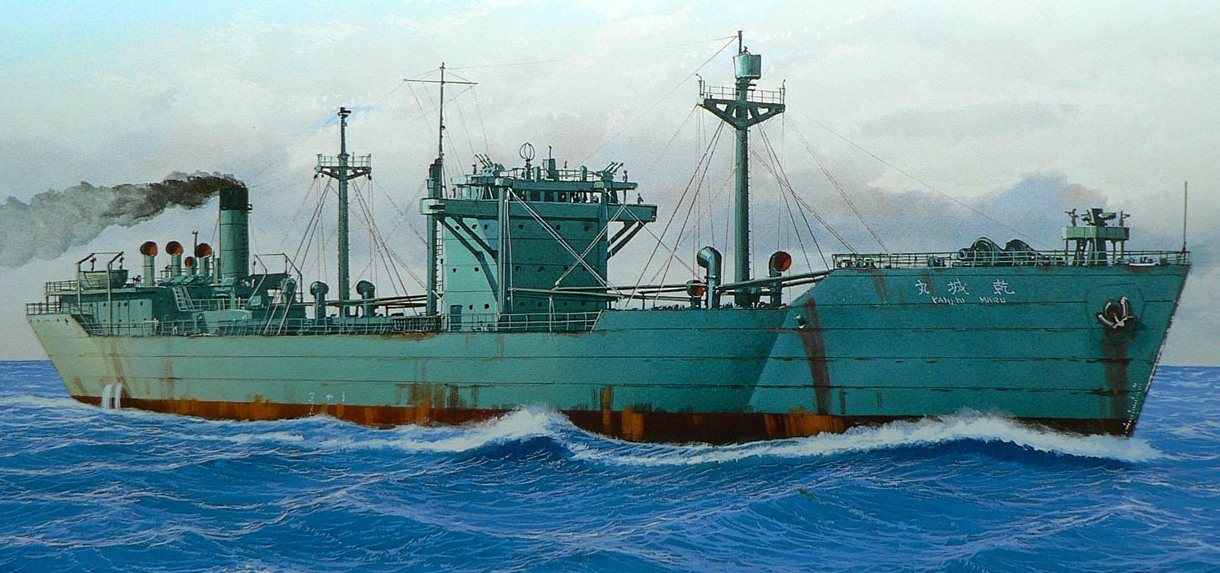YUSOSEN!
 (Standard 2AT Tanker KENJO MARU by Ueda Kihachiro)
(Standard 2AT Tanker KENJO MARU by Ueda Kihachiro)
ASOKAWA MARU
Tabular Record of Movement
© 2011 Bob Hackett
E 1943:
Tamano. Laid down at Mitsui Zosen K. K. shipyard as a 6,925-ton Type 2A Standard Cargo Ship for Kawasaki Kisen K. K., Kobe.
1944:
Converted to a Standard 2AT Tanker while on the ways.
1944:
Launched and named ASOKAWA MARU
14 September 1944:
Completed.
1 November 1944:
At 1800, ASOKAWA MARU departs Takao for Manila in convoy MOMA-06 consisting of transport HAMBURG MARU, tanker SHIMOTSU, TOTTORI, EIWA, ATLAS, DAITOKU, SHINSHO, KAKOGAWA, SEKIHO and SEIWA MARUs escorted by old destroyer KURETAKE, kaibokan CD-7, CD-1, CD-3, minesweeper W-27, subchaser CH-41 and fleet supply ship KURASAKI.
2 November 1944:
At 2305, LtCdr John B. Hess’s (USNA '37) USS POMFRET (SS-391) torpedoes and damages ATLAS MARU.
3 November 1944:
At 0435, Hess attacks ATLAS MARU again, but misses. At 0500, POMFRET also torpedoes and damages HAMBURG MARU. At 1850, one of the escorts scuttles her.
4 November 1944:
About 1330, ATLAS MARU goes aground. Torpedo boat SAGI arrives from Takao and joins the escort.
8 November 1944:
Off Cape Bolinaro, Luzon. LtCdr Guy E. O'Neil, Jr’s (USNA '37) USS GUNNEL (SS-253) torpedoes and sinks SAGI. The convoy later arrives at Santa Cruz, Philippines. Warned of a typhoon in the area, the convoy departs the same day and arrives at Manila Bay at 2238.
9 November 1944:
At 0925, convoy MOMA-06 arrives at Manila harbor.
November 1944:
ASOKAWA MARU departs Manila for Miri, Borneo in a convoy also consisting of two unidentified smaller merchant ships escorted by subchasers CH-30 and CH-31 and patrol boat PB-103.
12 November 1944:
Off Brunei. At 1035, while tracking another convoy, LtCdr Marshall H. Austin’s (USNA '35) USS REDFISH (SS-272) sights ASOKAWA MARU and her group. Austin begins an end-around approach on the surface, but at 1143, a Jake twin-float
reconnaissance seaplane is spotted and forces Austin to submerge.
At 2042, REDFISH, now running on the surface, fires its last four bow
Mark 23 steam torpedoes at 3,600 yards and gets one hit aft of ASOKAWA MARU’s bridge at 13-58N, 119-04E. Shortly thereafter, Austin is forced to fire three
Mark 18 electric torpedoes “down-the throat” at an escort at 1,200 yards range,
but they all miss.
19 November 1944:
Arrives at Miri. [1]
19 March 1945:
ASOKAWA MARU departs Seletar Naval Harbor, Singapore in convoy HI-88-J consisting of HONAN, KAIKO, SARAWAK, ARAOSAN, TENCHO and SAIGON MARUs escorted by destroyer AMATSUKAZE and kaibokan MANJU, CD-18, CD-26
CD-84, CD-130, CD-134 At 1310, while leaving the Singapore straits, SARAWAK MARU is mined and badly damaged and eventually sinks on 27 March.
22 March 1945:
Arrrives at Cape Camau, Indochina.
23 March 1945:
Off St Jacques, Indochina. ARAOSAN and TENCHO MARUs are detached.
27 March 1945:
Nha Trang Bay, Indochina. Convoy HI-88I is absorbed into a new convoy called HI-88J. Additional escorts are added. HI-88J now
consists of tankers ASOKAWA, HONAN, SARAWAK, ARAOSAN, TENCHO, SAIGON and KAIKO MARUs escorted by kaibokan MANJU, CD-1, CD-18, CD-26, CD-84, CD-130, CD-134 and destroyer AMATSUKAZE (with a temporary bow fitted).
28 March 1945:
At 0800, departs Nha Trang Bay. At 1040, an air attack begins. ASOKAWA MARU is hit in the engine room by bombs from a USAAF B-24 “Liberator” heavy bomber and sinks at 12-31N, 109-22E. Kaibokan MANJU and CD-84 rescue survivors.
Author’s Notes:
[1[ Ultra data based on a report by CH-30 is sketchy, but it seems probable that ASOKAWA MARU received emergency repairs at Miri and then underwent permanent repairs at Singapore.
- Bob Hackett
Back to the
Oilers Page





